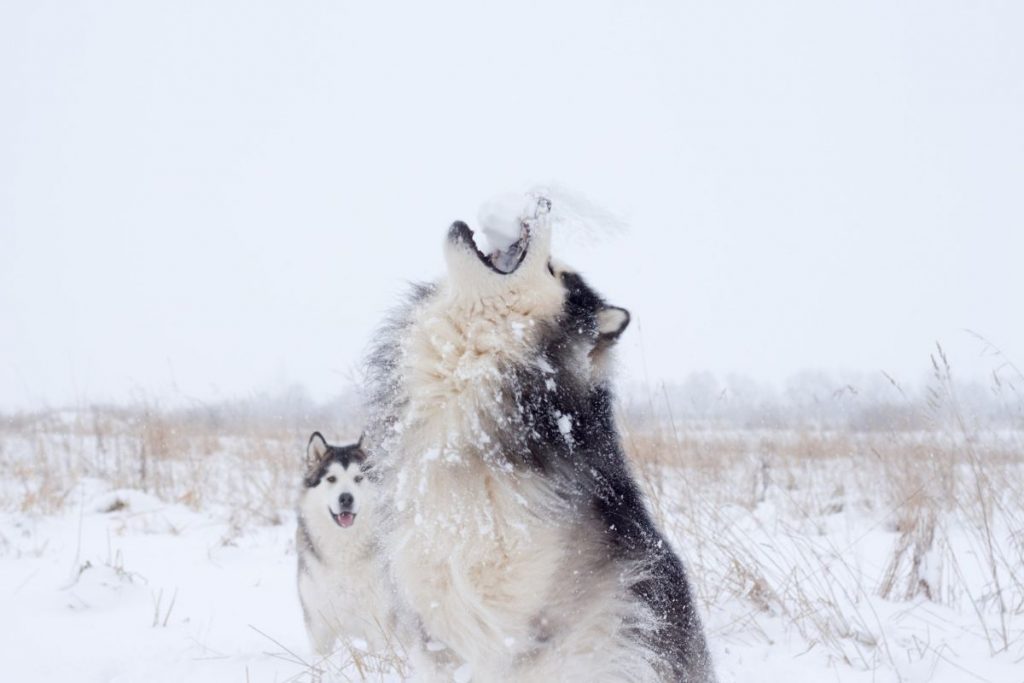Why do dogs howl at sirens? If you’ve ever found yourself wondering that (usually at 2 AM when their howling wakes you from a really great dream), you’re not alone.
What lies at the core of this primal behavior? What instinctual triggers prompt our furry friends to lend their voices to the sirens’ call? That’s exactly what we’re going to explore today, so keep reading!
The Science Behind Dog Howling
Dogs use a lot of different vocalizations to communicate with us and with each other. Howling is, at its core, just another vocalization used for communication.
Whenever I hear dogs howling in my neighborhood, I always think of that scene from 101 Dalmatians, after Cruella steals all of the puppies. Do you remember that? All of the dogs from London to the English countryside howl in succession, passing along a sort of “be on the lookout” message to each other.
Is that the purpose of howling, though? To pass on a BOLO or a warning? Let’s dig into the evolutionary origins to learn more.
The Evolutionary Origins of Howling
While recent studies debunk the “dogs are pack animals” theory, research suggests that our canine companions do still share a common ancestor with wolves.
In wolves, howling is an instinctive behavior passed down through generations and has evolved as a means of coordinating activities such as hunting, defending territory, and bonding with other pack members. Howling is a way for them to communicate over long distances.
Interestingly, howling is not just a means of communication for dogs. It also has a social function. When a dog howls, it can create a sense of unity among the family members and strengthen their social bonds. Howling can also be a sign of distress or anxiety, and it can indicate that a dog is in need of help or attention.

The Role of Frequency and Pitch in Dog Communication
Dogs have a significantly higher hearing range than humans and can detect sounds of different frequencies and pitches. So, the frequency and pitch of their howls convey different meanings. For instance, a low-pitched howl can indicate distress or aggression, while a high-pitched howl can signify excitement or enthusiasm.
Going back to the social function we mentioned above, researchers have found that the frequency of a dog’s howl can also vary depending on its emotional state. For example, a dog feeling anxious or stressed may produce a higher-pitched howl than a dog feeling relaxed or content. Similarly, a dog feeling threatened or scared may produce a lower-pitched howl than a dog feeling confident or dominant.
The Canine Hearing Range: A Key Factor in Siren Sensitivity
Sirens emit loud, high-pitched sounds that can be painful for dogs and trigger their howling behavior. Moreover, as dogs have evolved to howl as a means of communication, sirens may be perceived as a threat to their territory.
It’s important to note that not all dogs are equally sensitive to sirens. Some dogs may barely react to sirens, while others may howl uncontrollably. Factors such as breed, age, and individual temperament can all play a role in how a dog responds to sirens.
Basically, howling is a complex behavior that serves multiple functions for dogs. It is a means of communication, a way to strengthen social bonds, and a sign of the emotional state. By understanding the science behind howling, we can better understand our furry friends and deepen our relationship with them.

The Emotional and Behavioral Aspects of Howling
Howling is a unique behavior that dogs exhibit in response to various stimuli, such as sirens, music, or other dogs. While howling may seem simple and straightforward, it can be a complex and multi-faceted expression of a dog’s emotions and behavior.
Anxiety and Stress Responses in Dogs
Studies have shown that anxious or stressed dogs are more likely to howl in response to sirens. This behavior may be a coping mechanism for dogs to deal with their fear or anxiety, and the loud howls may serve as a release of pent-up emotions. Dogs that are prone to anxiety or stress may exhibit other behaviors, such as pacing, panting, or trembling, in addition to howling.
It is crucial for dog owners to recognize the signs of anxiety and stress in their pets and provide them with a safe and secure environment. This may include providing a quiet and comfortable space for the dog to retreat to, using calming aids such as pheromone sprays or supplements, or seeking the advice of a veterinarian or professional dog behaviorist.
Territorial Behavior
Dogs may not be pack animals, but they ARE territorial animals, and they may perceive sirens as threatening their territory. Howling can be a way for dogs to warn other family members about potential danger and defend their territory against an unknown intruder.
This behavior is especially common in dogs that live in urban areas, where the sound of sirens is a frequent occurrence.
Attention-seeking and Social Bonding
Dogs are social animals that crave human attention and affection. Howling can be a way for dogs to seek attention from their owners or other pack members.
Dogs may howl when they are left alone for long periods of time or when they feel neglected or ignored.
Howling is a complex and multi-faceted behavior that can provide insight into a dog’s emotions and behavior. By understanding the various reasons why dogs howl, pet owners can better meet their pet’s needs and provide a happy and healthy environment for their furry friends.
The Different Types of Sirens and Their Effects on Dogs
As we delve deeper into the intriguing world of canine howling, it’s important to understand that not all sirens are created equal. Different types of sirens can evoke varied responses from our furry friends.
From the distant wails of emergency vehicle sirens to the melodious tones of musical instruments, let’s unravel the intriguing interplay between these auditory signals and your dog’s instinctive reactions.
Police Sirens: A Common Trigger for Howling
Police sirens emit loud, high-pitched sounds that can trigger intense howling in dogs. This behavior may be attributed to the association of sirens with police cars, which are often associated with danger or the presence of intruders. Dogs have a keen sense of hearing, and the sound of a police siren can be particularly distressing to them. This is especially true for breeds that are known for their protective instincts, such as German Shepherds and Rottweilers.
It is important to note that howling in response to police sirens is not necessarily a bad thing. In fact, it can be a sign that your dog is alert and aware of its surroundings. However, if your dog’s howling becomes excessive or disruptive, it may be a sign of anxiety or stress.
Fire Truck and Ambulance Sirens: Variations in Response
Fire truck and ambulance sirens emit sounds that are different from police sirens. These sirens may elicit a different response in dogs, depending on their breed, temperament, and environment. Some dogs may exhibit intense howling, while others may simply bark or become agitated.
Interestingly, some dogs may not respond at all to fire trucks or ambulance sirens. This may be due to a variety of factors, such as their level of exposure to these sounds, their age, or their overall temperament. For example, older dogs may be less likely to respond to sirens than younger dogs, as they may have become accustomed to the sounds over time.
Other Loud Noises That May Trigger Howling
While sirens are a common trigger for howling in dogs, they are not the only loud noise that can elicit this behavior. Dogs can exhibit howling behavior in response to other loud noises, such as thunderstorms, fireworks, and vacuum cleaners. These noises can trigger a stress response in dogs and cause them to howl as a means of coping with their fear or anxiety.
If your dog exhibits excessive howling behavior in response to loud noises, it is important to address the underlying cause of their anxiety. This may involve desensitization training, the use of calming aids, or other behavioral interventions.
In conclusion, howling in response to sirens is a common behavior among dogs that can be attributed to a variety of factors. By understanding the different types of sirens and their effects on dogs, pet owners can better understand their furry friends and provide them with the care and support they need.
How to Manage and Reduce Siren-Induced Howling
While the mesmerizing call of sirens might set off an irresistible urge in our dogs to join the chorus, there are effective strategies to manage and minimize their howling episodes.
By implementing targeted training techniques, creating soothing environments, and introducing engaging distractions, you can navigate this natural behavior and ensure a harmonious coexistence between your furry friend and the captivating world of sirens.
Desensitization and Counter-Conditioning Techniques
Desensitization and counter-conditioning techniques are effective ways to manage siren-induced howling behavior in dogs.
These techniques involve gradually exposing your dog to the sound of sirens and rewarding them for displaying calm behavior. Over time, your dog will learn to associate sirens with positive experiences and become less reactive to the sound.
Check out the video below for some tips:
Creating a Safe and Comfortable Environment
Dogs that exhibit siren-induced howling may benefit from a safe and comfortable environment that minimizes exposure to outside noises. This can include noise-reducing curtains, soundproofing, and positive reinforcement training.
Training Tips for Discouraging Unwanted Howling
Training your dog to stop unwanted howling can be achieved through various techniques, such as the “quiet” command or distracting your dog with toys or treats. Consistency and positive reinforcement are crucial when training your dog to stop excessive howling.
Conclusion
In conclusion, howling behavior in dogs can be a complex and fascinating topic. A deeper understanding of the scientific, emotional, and behavioral aspects of howling can help dog owners better manage their dogs’ howling behavior and create a more comfortable environment for them to thrive.


